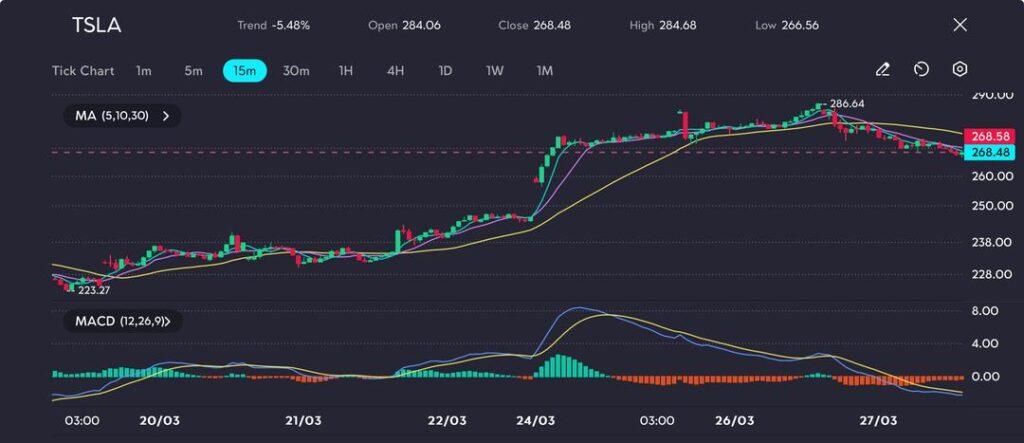
Tesla’s latest stock dip shows how trade policy can shake up the automotive market. With new tariffs raising questions about costs and global demand, investors are reassessing the road ahead for the EV giant.
Tesla Inc. (TSLA) saw its share price decline by 5.48%, closing at USD 268.48 on Thursday after President Donald Trump announced a sweeping 25% tariff on all imported cars and light trucks, effective from 3 April.
Although Trump assured the public that the move would be “net neutral” for Tesla, the market reaction was swift, with the stock plunging from an intraday high of USD 284.68. This marked one of Tesla’s steepest one-day losses this quarter.
The selloff wasn’t isolated to Tesla; it came amid broader declines in auto stocks globally. Concerns quickly arose about increased costs, a potential drop in vehicle demand, and the likelihood of retaliatory tariffs from key US trade partners.
Even though Tesla is less dependent on imported vehicles than traditional automakers, the company remains exposed due to its reliance on international supply chains, particularly for batteries, lithium, cobalt, and other crucial components.
Tesla also depends on foreign markets such as Europe and Asia for significant growth opportunities.
Tesla (TSLA) had been on a strong upward trajectory, rising from USD 223 on 20 March to a high of USD 286.64 by 26 March.
However, the upward momentum has now stalled, with the stock retreating to USD 268.48.

This decline has caused Tesla’s share price to dip below key short-term moving averages, with the 10-day moving average now acting as resistance.
Additionally, the MACD indicator has signalled a bearish crossover, with the histogram turning increasingly negative—indicating growing selling pressure.
While Tesla’s broader long-term uptrend remains intact, short-term weakness could persist unless the stock manages to break back above the USD 275–USD 280 resistance range.
Although President Trump claimed Tesla would gain a competitive edge due to reduced foreign competition, the real impact of these tariffs may be more nuanced.
Tesla’s exposure to global supply chains could still leave it vulnerable to retaliatory trade measures. The company exports Model 3 and Model Y vehicles to markets such as Germany, South Korea, and Japan, where reciprocal tariffs are likely to emerge.
Moreover, rising prices could deter consumers just as Tesla ramps up production of its Cybertruck and continues expanding its manufacturing capacity.
The Centre for Automotive Research has cautioned that new tariffs could add thousands of dollars to the cost of new cars, reducing demand.
Similarly, trade organisations like Autos Drive America have expressed concerns about reduced consumer choice, inflated prices, and potential disruptions to manufacturing stability.
Tesla’s 5.5% drop reflects more than just an initial reaction to the tariff news. Traders are increasingly factoring in the risks of higher production costs, political instability, and potential slowdowns in demand due to the volatility in global trade.
While Tesla is still holding above some key medium-term support levels, the weakening momentum cannot be ignored.
Investors are now closely watching upcoming events, including the PCE inflation report and Tesla’s vehicle delivery data, for further insights.
If reciprocal tariffs are implemented on 2 April, or if foreign governments target US-made electric vehicles, Tesla’s outlook could face even more headwinds.
For now, the company must navigate these turbulent conditions and hope to reclaim upward momentum in the weeks ahead.
Click here to open account and start trading.